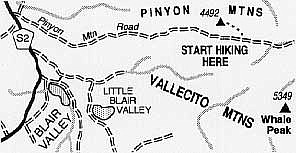 Facebook
Facebook
 X
X
 Instagram
Instagram
 TikTok
TikTok
 Youtube
Youtube
The early-autumn sun continues to scorch the desert's lowest elevations, yet it far more kindly illuminates the 4000-foot plateau of Pinyon Mountain Valley, high amid Anza-Borrego's central mountain range -- the Vallecito Mountains. Eighty-degree days and clear, cool, star-filled nights await adventurous car-campers who navigate their vehicles into this secluded bit of flatland. Two pinyon-pine-studded ridges flank the valley north and south, the southern of the two containing Whale Peak, a favorite destination among desert "peak baggers." An easier hike, better suited for warm-weather hiking, leads to the ridge north of the valley.
Pinyon Mountains
Remember that you'll need a state-park pass if you're going to drive off of any paved road in the Anza-Borrego State Park. For information, call 760-767-4205 or 760-767-5311. For this trip, the dirt-road phase (high clearance is recommended, 4-wheel drive helps) begins as you turn east from Highway S-2 (at mile 21.4) onto the signed Pinyon Mountain Road. This intersection is 3.2 miles south of Highway 78 at Scissors Crossing. Stay right (east) as another dirt road forks left at 0.1 mile, and continue on a gently twisting road that is never very steep but occasionally fraught with short passages over sharply protruding rocks. At 5.7 miles the road attains a broad summit -- Pinyon Mountain Valley -- where you can find a place to park in either a turnout along the main dirt road or along one of the road spurs leading north or south.
The 4492-foot-high point of the Pinyon Mountains (a sub-range within the Vallecito Mountains) swells just north of Pinyon Mountain Valley, and the two-mile round-trip, cross-country hike to the summit is an ideal recreational pursuit during the hour or two before sunset, or the hour or two after sunrise. From the top, the ridge of Whale Peak swells across the southern horizon, blocking distant views in that direction. Opposite, however, is a sweeping vista of the San Ysidro and Santa Rosa Mountains, Borrego Valley, the Borrego Badlands, and the Salton Sea -- the entire landscape colored by the blue shadows that are either advancing or retreating across the desert floor.


The early-autumn sun continues to scorch the desert's lowest elevations, yet it far more kindly illuminates the 4000-foot plateau of Pinyon Mountain Valley, high amid Anza-Borrego's central mountain range -- the Vallecito Mountains. Eighty-degree days and clear, cool, star-filled nights await adventurous car-campers who navigate their vehicles into this secluded bit of flatland. Two pinyon-pine-studded ridges flank the valley north and south, the southern of the two containing Whale Peak, a favorite destination among desert "peak baggers." An easier hike, better suited for warm-weather hiking, leads to the ridge north of the valley.
Pinyon Mountains
Remember that you'll need a state-park pass if you're going to drive off of any paved road in the Anza-Borrego State Park. For information, call 760-767-4205 or 760-767-5311. For this trip, the dirt-road phase (high clearance is recommended, 4-wheel drive helps) begins as you turn east from Highway S-2 (at mile 21.4) onto the signed Pinyon Mountain Road. This intersection is 3.2 miles south of Highway 78 at Scissors Crossing. Stay right (east) as another dirt road forks left at 0.1 mile, and continue on a gently twisting road that is never very steep but occasionally fraught with short passages over sharply protruding rocks. At 5.7 miles the road attains a broad summit -- Pinyon Mountain Valley -- where you can find a place to park in either a turnout along the main dirt road or along one of the road spurs leading north or south.
The 4492-foot-high point of the Pinyon Mountains (a sub-range within the Vallecito Mountains) swells just north of Pinyon Mountain Valley, and the two-mile round-trip, cross-country hike to the summit is an ideal recreational pursuit during the hour or two before sunset, or the hour or two after sunrise. From the top, the ridge of Whale Peak swells across the southern horizon, blocking distant views in that direction. Opposite, however, is a sweeping vista of the San Ysidro and Santa Rosa Mountains, Borrego Valley, the Borrego Badlands, and the Salton Sea -- the entire landscape colored by the blue shadows that are either advancing or retreating across the desert floor.
